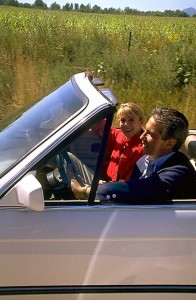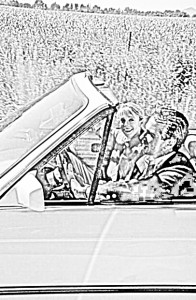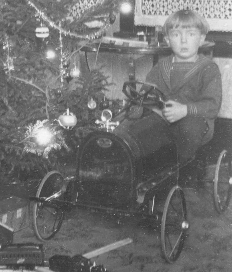1. What are the people in the picture doing?
The people are going for a drive in the car.
2. What do you call a car without a roof?
A car without a roof is called a convertible.
3. What kind of road do you suppose the car is driving on?
It looks like the car is driving on a country road, or perhaps on an interstate or expressway.
4. What do you call the person who controls the car?
The person who controls the car is called the driver.
5. What do you call a person who is not controlling the car?
Someone who is not controlling the car is called a passenger.
6. What is a driver’s license?
A driver’s license is a document which signifies that a person enjoys the legal privilege of being able to drive a car.
7. When you prepare to drive a car somewhere, what sort of things do you have to do?
When you prepare to drive a car, there are several things that you have to do. You have to put on your seatbelt, adjust the seat and mirrors if necessary, turn on the ignition, and put the car in gear. If you are parked in a driveway, you might have to back up the car in order to get it onto the road.
8. What does a seatbelt do?
A seatbelt restrains the driver and/or passengers in the event of a car crash.
9. What does the driver use mirrors for?
The driver uses the mirrors to view the traffic behind him, and to see where he is going if he has to drive the car in reverse.
10. Why is the dashboard important to the driver?
The dashboard is important to the driver because he is able to view the speedometer, the gas gauge, and other important instruments that let him know how the car is currently functioning.
11. What does the speedometer do?
The speedometer tells the driver how fast the car is going. It also usually tells the total number of miles the car has been driven.
12. How does the driver make the car go?
The driver makes the car go by putting the car in gear and stepping on the gas pedal (accelerator).
13. How does the driver steer the car?
The driver steers the car with the steering wheel.
14. What do wipers do?
The wipers clean the windshield of rain and snow, keeping it clear so the driver can see the road.
15. What do turn signals do?
Turn signals indicate to other drivers that the car is going to turn.
16. What does the driver use cruise control for?
The driver uses cruise control to keep the car at a constant speed, usually while driving on an expressway or interstate.
17. What part of the car is under the hood?
The engine is under the hood.
18. What is the trunk of a car?
The trunk of the car is where luggage and other parcels can be put. Often, a spare tire or other emergency equipment is also kept there.
19. Where is the fuel for a car stored?
The fuel for a car is stored in the car’s gas tank.
20. What sorts of road signs must a driver pay attention to?
The driver needs to pay attention to stop signs, speed limit signs, no passing zone signs, traffic lights, and direction signs.
Paragraph: Driving a Car
Have you ever driven a car? Are you learning how to drive? Do you like to drive? Write a brief paragraph about your driving experiences.
I remember when I got my driver’s license. I had turned sixteen several weeks earlier, but I decided to wait for several reasons. For one thing, all the cars in the driver’s ed course at school had automatic transmission, but all our family cars had manual transmission, and I was not especially confident in driving a stick shift. I felt I needed the extra time to become more proficient. Also, my birthday was in the winter, and I wasn’t too keen on trying to take my driver’s test on snowy roads.
So, one day during spring break, my mother took me to the driver’s license facility to get my driver’s license. I was very nervous, and my nervousness was made all the worse because I had to wait until a driver’s license examiner was available. At long last my turn came, and the examiner came out with me to my car. He observed me as I came out of the parking lot, and instructed me to turn onto the main road. I drove down the road, which had a stop sign at the end. I figured that the examiner would be picky about coming to a full stop, so I made sure that I completely stopped the car at the stop line.
However, when I went to make a turn at the stop sign, I had trouble with the car dying on me. I couldn’t understand what was wrong with the car until the examiner asked, “Why don’t you try putting the car into first?” When I had come to the stop sign, I had already gotten the car into third gear, and in my nervousness I completely forgot to go back to first gear after having stopped. I thought for sure the examiner was going to flunk me, but he must have had pity on me or something, because he passed me nonetheless. I was so glad to have the ordeal of a driving test behind me!




